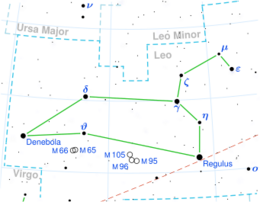Astronomy:K2-18
Approximate two-dimensional location of the star (in red circle); Sigma Leonis is the nearest bright star, which is in a southerly direction, and the boundary of Virgo is similarly far. | |
| Observation data Equinox J2000.0]] (ICRS) | |
|---|---|
| Constellation | Leo |
| Right ascension | 11h 30m 14.51774s[1] |
| Declination | +07° 35′ 18.2553″[1] |
| Apparent magnitude (V) | 13.50[2] |
| Characteristics | |
| Evolutionary stage | Red dwarf |
| Spectral type | M2.8[3] |
| Astrometry | |
| Radial velocity (Rv) | 0.02±0.52[1] km/s |
| Proper motion (μ) | RA: −80.479[1] mas/yr Dec.: −133.007[1] mas/yr |
| Parallax (π) | 26.2469 ± 0.0266[1] mas |
| Distance | 124.3 ± 0.1 ly (38.10 ± 0.04 pc) |
| Details | |
| Mass | 0.495±0.004[4] M☉ |
| Radius | 0.469±0.010[4] R☉ |
| Luminosity | 0.0234[5] L☉ |
| Temperature | 3,503±60[4] K |
| Metallicity [Fe/H] | 0.123±0.157[6] dex |
| Rotation | 39.6±0.9 d[7] |
| Age | 2.4±0.6[7] Gyr |
| Other designations | |
| Database references | |
| SIMBAD | data |
K2-18, also known as EPIC 201912552, is a red dwarf star with two planetary companions located 124 light-years (38 parsecs)[4] from Earth, in the constellation of Leo.
Planetary system
The star has a transiting exoplanet, called K2-18b, a super-Earth located within the habitable zone of K2-18.[8][9] It was discovered in 2015 by the Kepler space telescope in its K2 mission.[3] It is the first exoplanet in the habitable zone, albeit a hydrogen-rich sub-Neptune,[10] to have its atmosphere characterized; initially thought to contain water vapor,[11] more recent observations have instead detected methane and carbon dioxide.[12] The presence of these molecules and non-detection of ammonia is consistent with predictions for a hycean planet.[12]
A second, non-transiting planet, K2-18c, was discovered in 2017 by radial velocity with HARPS.[13] This planet was challenged by another team with CARMENES data,[14] but its existence was reaffirmed by the discovery team based on both HARPS and CARMENES data.[4] This planet has also been confirmed by a later independent study.[15] System tidal simulation suggests that K2-18c is a gas-rich, Neptune-like planet, similar to K2-18b.[16]
| Companion (in order from star) |
Mass | Semimajor axis (AU) |
Orbital period (days) |
Eccentricity | Inclination | Radius |
|---|---|---|---|---|---|---|
| c | ≥5.62±0.84 M⊕ | 0.0670 ± 0.0002 | 9.2072±0.0065[15] | <0.2 | — | — |
| b | 8.63±1.35 M⊕ | 0.1591±0.0004 | 32.94488±0.00281 | — | — | 2.711±0.065 R⊕ |
References
- ↑ 1.0 1.1 1.2 1.3 1.4 Vallenari, A. et al. (2022). "Gaia Data Release 3. Summary of the content and survey properties". Astronomy & Astrophysics. doi:10.1051/0004-6361/202243940 Gaia DR3 record for this source at VizieR.
- ↑ Zacharias, N.; Finch, C. T.; Girard, T. M.; Henden, A.; Bartlett, J. L.; Monet, D. G.; Zacharias, M. I. (2012). "VizieR Online Data Catalog: UCAC4 Catalogue (Zacharias+, 2012)". VizieR On-line Data Catalog. Bibcode: 2012yCat.1322....0Z.
- ↑ 3.0 3.1 Montet, Benjamin T. et al. (5 August 2015). "Stellar and Planetary Properties of K2 Campaign 1 Candidates and Validation of 17 Planets, Including a Planet Receiving Earth-like Insolation". The Astrophysical Journal 809 (1): 25. doi:10.1088/0004-637X/809/1/25. Bibcode: 2015ApJ...809...25M.
- ↑ 4.0 4.1 4.2 4.3 4.4 Cloutier, Ryan et al. (7 January 2019). "Confirmation of the radial velocity super-Earth K2-18c with HARPS and CARMENES". Astronomy & Astrophysics 621: A49. doi:10.1051/0004-6361/201833995. Bibcode: 2019A&A...621A..49C.
- ↑ Martinez, Arturo O. et al. (2017). "Stellar and Planetary Parameters for K2's Late-type Dwarf Systems from C1 to C5". The Astrophysical Journal 837 (1): 72. doi:10.3847/1538-4357/aa56c7. Bibcode: 2017ApJ...837...72M.
- ↑ Benneke, Björn et al. (2017). "Spitzer Observations Confirm and Rescue the Habitable-zone Super-Earth K2-18b for Future Characterization". The Astrophysical Journal 834 (2): 187. doi:10.3847/1538-4357/834/2/187. Bibcode: 2017ApJ...834..187B.
- ↑ 7.0 7.1 Guinan, Edward F.; Engle, Scott G. (2019-12-12). "The K2-18b Planetary System: Estimates of the Age and X-UV Irradiances of a Habitable Zone "Wet" Sub-Neptune Planet". Research Notes of the AAS 3 (12): 189. doi:10.3847/2515-5172/ab6086. ISSN 2515-5172. Bibcode: 2019RNAAS...3..189G.
- ↑ "HABITABLE EXOPLANETS CATALOG". UPR. 7 March 2016. http://phl.upr.edu/projects/habitable-exoplanets-catalog.
- ↑ "EPIC 201912552 b reality check drewexmachina 11-22-2015". Drew ExMachina. 7 March 2016. http://www.drewexmachina.com/2015/05/12/habitable-planet-reality-check-epic-201912552b/.
- ↑ No, the Exoplanet K2-18b Is Not Habitable
- ↑ Benneke, Björn; Wong, Ian; Piaulet, Caroline; Knutson, Heather A.; Lothringer, Joshua; Morley, Caroline V.; Crossfield, Ian J. M.; Gao, Peter et al. (December 2019). "Water Vapor and Clouds on the Habitable-zone Sub-Neptune Exoplanet K2-18b" (in en). The Astrophysical Journal Letters 887 (1): L14. doi:10.3847/2041-8213/ab59dc. ISSN 2041-8205. Bibcode: 2019ApJ...887L..14B.
- ↑ 12.0 12.1 Madhusudhan, Nikku; Sarkar, Subhajit; Constantinou, Savvas; Holmberg, Måns; Piette, Anjali A. A.; Moses, Julianne I. (1 October 2023). "Carbon-bearing Molecules in a Possible Hycean Atmosphere". The Astrophysical Journal Letters 956 (1): L13. doi:10.3847/2041-8213/acf577. Bibcode: 2023ApJ...956L..13M.
- ↑ Cloutier, R. et al. (December 2017). "Characterization of the K2-18 multi-planetary system with HARPS. A habitable zone super-Earth and discovery of a second, warm super-Earth on a non-coplanar orbit". Astronomy & Astrophysics 608: A35. doi:10.1051/0004-6361/201731558. Bibcode: 2017A&A...608A..35C.
- ↑ Sarkis, Paula et al. (June 2018). "The CARMENES Search for Exoplanets around M Dwarfs: A Low-mass Planet in the Temperate Zone of the Nearby K2-18". The Astronomical Journal 155 (6): 257. doi:10.3847/1538-3881/aac108. Bibcode: 2018AJ....155..257S.
- ↑ 15.0 15.1 Radica, Michael et al. (December 2022). "Revisiting radial velocity measurements of the K2-18 system with the line-by-line framework". Monthly Notices of the Royal Astronomical Society 517 (4): 5050–5062. doi:10.1093/mnras/stac3024. Bibcode: 2022MNRAS.517.5050R.
- ↑ 16.0 16.1 Ferraz-Mello, S.; Gomes, G. O. (2020). "Tidal evolution of exoplanetary systems hosting potentially habitable exoplanets. The cases of LHS-1140 b-c and K2-18 b-c". Monthly Notices of the Royal Astronomical Society 494 (4): 5082–5090. doi:10.1093/mnras/staa1110. Bibcode: 2020MNRAS.494.5082G.
Coordinates: ![]() 11h 30m 14.518s, +07° 35′ 18.257″
11h 30m 14.518s, +07° 35′ 18.257″
External links
 |



